Nepal is a Himalayan country that offers diverse varieties of trekking routes to trekkers worldwide. Trekking in Nepal rewards the trekkers with enticing views of the Himalayas, diverse landscapes, and rich biodiversity and gives insights into the diverse culture and traditions of the locals. Amongst many treks in Nepal, Annapurna Circuit Trek is one of the most popular treks in Nepal.
Hiking around the Annapurna Circuit is a lifetime experience in the breathtaking landscapes of the Annapurna region. Considered the best long-distance trek globally, Annapurna Circuit is a moderate-level trek that fits well for trekkers of any skill level.
However, preparing for the trek is crucial for any trekking journey. Most of my clients bombard me with inquiries about “what if”s and “but what about”s regarding the Annapurna Circuit Trek. So, in this article, I’ll try to answer all the questions and describe how to prepare and plan for the Annapurna Circuit Trek.
Read the detailed description below on preparing for Annapurna Circuit Trek for a lifetime trekking adventure!
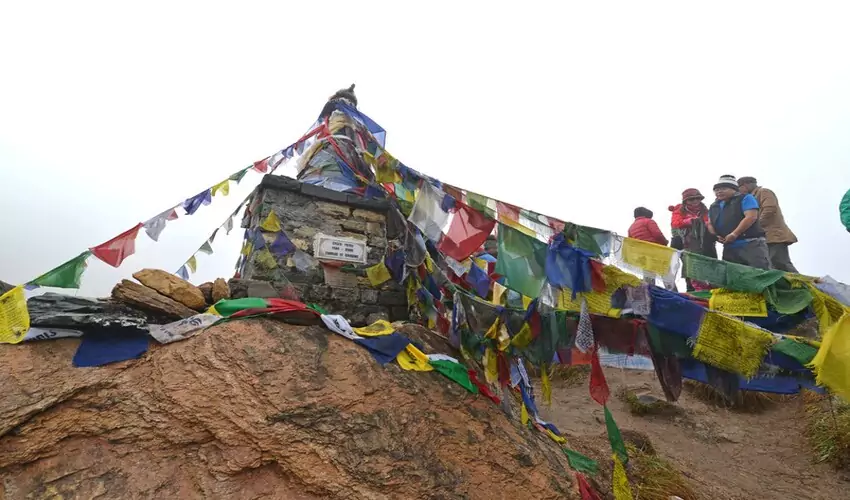
Significant Highlights of Annapurna Circuit Trek
- One of the most famous treks in the world that covers a large number of Himalayan Ranges.
- Explore the varieties of communities, vegetation, landscapes, rivers, food, culture, etc., of the Annapurna Region.
- Crossing Thorong La Pass (5416m), one of the highest passes in the world, is an achievement.
- An opportunity to socialize and share experiences with travelers from all over the world as it is a very famous trekking package.
- Experience the sheltered life of people living in the Annapurna Region from a close distance.
- Relax your body at the hot spring in Tatopani.
- Witness the breathtaking sunrise view over the Annapurna Massif from Poonhill.
How long does it take to hike the Annapurna Circuit?
The Annapurna Circuit Trek usually takes from 18 to 20 days to complete. However, the trek’s duration depends on the trekker’s physical ability along with the trekking experience. If you are a new hiker or of average fitness, 18 to 20 days sounds right. Experienced trekkers tend to complete the trek much quicker.
Furthermore, the duration also depends on the acclimatization days you take during the trek. It is possible if you are short on time and want to complete the trek quicker. Due to the recent construction, jeep roads pass through many villages along the trekking trail.
So, you can directly take the jeep up as far as Manang Village. After crossing the legendary Thorong La Pass, you can get the jeep when you reach Muktinath or even hike down to Jomson to catch a bus. Although you can complete the trek in a shorter time, you will miss a lot of good stuff and not acclimatize well.
Brief Itinerary of Annapurna Circuit Trek
Day 01: Arrival at Kathmandu Tribhuvan International Airport
Day 02: Drive to Chamje
Day 03: Trek from Chamje to Dharapani
Day 04: Trek to Chame
Day 05: Trek to Pisang
Day 06: Trek to Mangng via Ghyaru
Day 07: Acclimatization day in Manang
Day 08: Trek to Yak Kharka
Day 09: Trek to Thorong Phedi (4650m) or High Camp (4800)
Day 10: High camp to Muktinath via Thorang pass (5416m)
Day 11: Jeep driving to Tatopani (1100 m)
Day 12: Trek to Ghorepani (2800m)
Day 13: Early morning hike to Poon Hill, descend to Tikhedhunga and drive to Pokhara.
Day 14: Drive from Pokhara to Kathmandu
Day 15: Departure
For a detailed Itinerary, please read our blog on “15 Days Annapurna Circuit Trek.”
Annapurna Circuit Trek Route Map
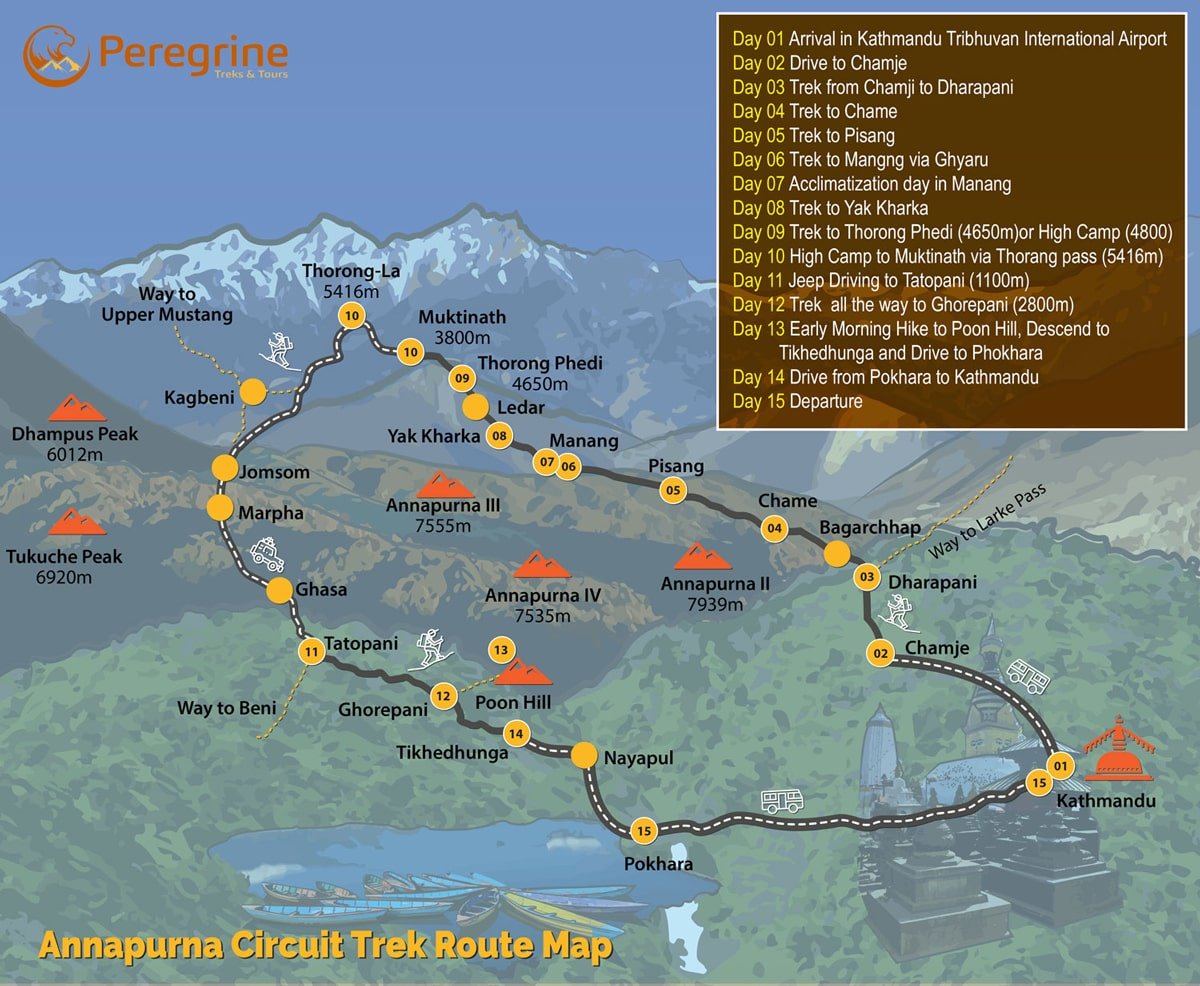
When is the Best Time for the Annapurna Circuit Trek?
Hiking through the Annapurna Circuit is doable throughout the year. However, to get the best of the Annapurna Circuit, autumn (September to November) and spring (March to May) are the best times to trek.
Annapurna Circuit Trek in Spring season (March-May)
The Spring season is the best time to hike the Annapurna Circuit. Due to its stable weather and temperature, most trekkers prefer to hike during this season.
Spring offers clear blue skies that reward the trekkers with unobstructed views of the mountain peak. Vegetations are at full blossom during the spring season. Thus, the hills are covered with colorful wildflowers and blossoms, including the rhododendron flower, the national flower of Nepal.
The temperature is moderate, perfect for trekking in the daytime, but the nighttime temperature drops pretty low, but it is bearable. There are no heavy rainfalls during spring, and the sky remains mostly clear.
Annapurna Circuit Trek in Autumn (September to December)
The months of September to December are the autumn months in Nepal. The Annapurna region looks beautiful in the autumn season. Moreover, the post-monsoon period means that the clouds are clear, and you can observe unobstructed views of the mountains.
Furthermore, the higher elevation zone is colder, whereas the lower elevation zone remains warmer in Autumn. The region’s festive atmosphere is also the trek’s major attraction as significant festivals like Dashain, Tihar, and Holi fall in autumn. The lively cultural exploration during the trek will make you love the place.
Besides these, the offseason treks are also possible in the Annapurna region. In these seasons, the risk of landslides and avalanches in the monsoon season and the freezing conditions in the winter also pose a threat. However, the Annapurna Circuit Trek is doable throughout the year with proper preparation.
How Much Does Annapurna Circuit Trek Cost?
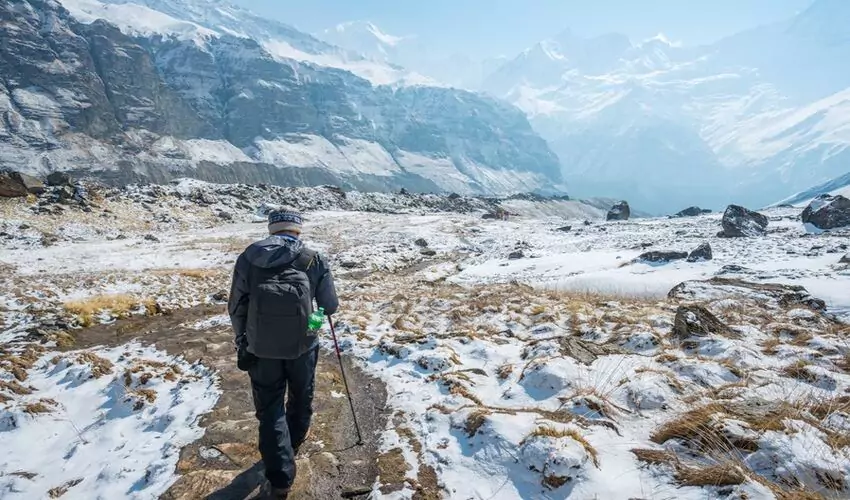
While planning for the trek, you must find an estimate of the budget you will be spending during the Annapurna Circuit Trek. Many factors determine the Annapurna Circuit Trek Cost, such as the duration of the trek, transportation you take, trekking permits which we will discuss below, whether you are hiring a guide or porters, and many other factors. Depending on these factors, you can get a rough idea of the budget you will require for the trek.
Usually, hiring a local trekking agency can cost you around USD 1000 to USD 1500 for 15 days of trekking in the Annapurna Circuit. However, if you book the trek from international travel agencies, it will be much more expensive.
Generally, it can cost you from USD 1500 to USD 4500. Thus, it is better to choose a local agency than an international agency, as it will be much cheaper and also help to grow the local economy.
However, if you don’t want to hire any trekking agencies, here is the general cost of each service and facility you will be spending. This will help you plan the Annapurna Circuit Trek as per your budget.
- Visa costs: USD 30 for 15 days, USD 50 for 30 days, and USD125 for 90 days
- Transportation Costs: USD 6 to 7 via a local bus (one way), USD 120 to 150 if you hire a private jeep (One way)
- Food Cost: USD 5 to 10 per meal depending upon the altitude
- Accommodation Cost: USD 1 to 3 per night
- Travel Insurance: USD 150, on average (based on 30 days cover)
- Cost of Guides and Porters: USD 30 to 35 per day for a guide and a porter USD 18 to 20 per day
- Cost of Trekking gear: Depends on you. If you are low on money, you can easily hire them from Thamel or Pokhara for USD 1 to 5 for each item per day.
Required Permits for Annapurna Circuit Trek
You will require two permits to trek in the Annapurna region. You will have to show these permits at various checkpoints along the trail. The Annapurna Circuit Trek permits and its costs are as follows:
Trekkers Information Management System Card (TIMS)
- SAARC personals: NPR 600, about $6 for individual trekkers, and NPR 300, about $3 for groups.
- All other personals: NPR 2,000, about $20 for individual trekkers, and NPR 1000, about $10 for groups.
Annapurna Conservation Area or ACAP
- SAARC personals: NPR 200, about $2
- ALL other personals: NPR 3,000, about $30
Note: You can get these permits at the Nepal Tourism Board (NTB) in Kathmandu. Take your passport along with you.
Logistical Details
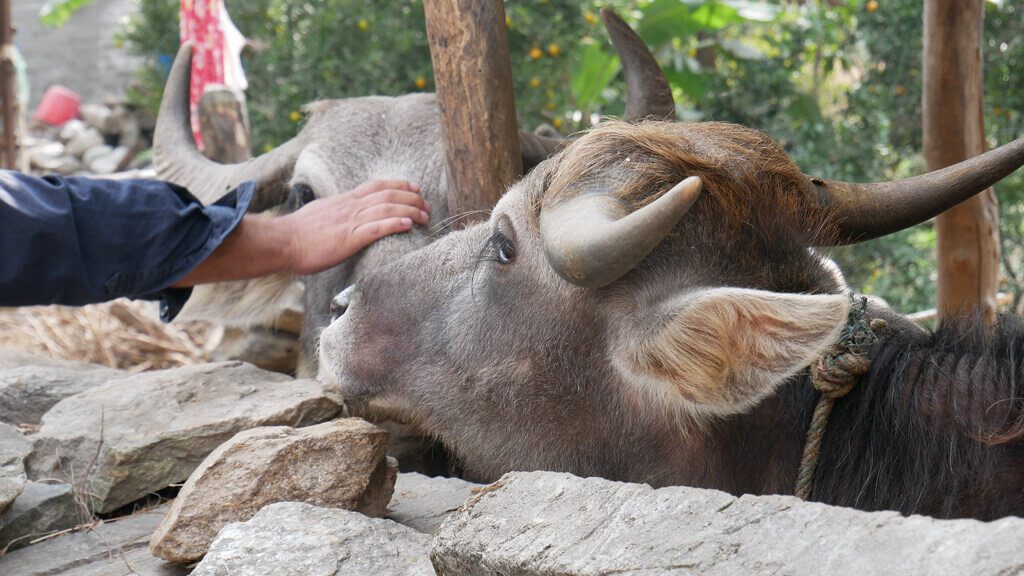
1. Transportation
The cheapest way to travel to the starting point of this trek, i.e., Besi Sahar, is to take a local bus from either Kathmandu or Pokhara. You can also ride further to Bahundanda. It will take around 7 to 8 hours to reach the trailhead, costing you around $10.
You should get the bus ticket a day before leaving as the bus will leave early in the morning. This will also give you the time to know where the bus leaves and at what time.
If you are in Kathmandu, you can get the ticket from Gongabu Bus Station, also known as New Bus Park. And if you are in Pokhara, ask for the local bus station because the tourist buses leave from a different location.
2. Money
During trekking in Nepal, you will be trekking in remote areas of Nepal where there won’t be any ATM facilities. Thus, you won’t find any ATMs in the Annapurna Circuit Trail except in Jomsom. However, the ATM in Jomsom is unreliable; don’t get entirely dependent on it.
The last reliable ATM you will find while going for the Annapurna Circuit Trek is at Pokhara. So, take out all the money you will need for the hike. Since ATMs are not dependable in Nepal and VISA cards are not accepted during the remote trek, you must have all your money in cash. You will require about $25 to $30 per day. So, take the money according to the duration of your trek.
Related articles you may like:
What To Pack For The Annapurna Circuit Trek?
Some of the essential items that you need to pack for the Annapurna Circuit Trek are as follows:
1. Clothing
- Trekking boots
- Short-sleeved Trekking shirts
- Trekking pants and jackets
- Thermals underwear
- Long-sleeved Trekking shirts
- Insulating down jackets
- Woolen cap
- Trekking Gloves
- Raincoats
2. First Aid
- Diamox tablets
- Sanitary pads / Tampons
- Anti-nausea Medicines
- Band-aids
- Mosquito and insect repellents
3. Toiletries
- Soap
- Toilet Paper
- Shampoo
- Sunscreen
- Moisturizer
- Hand sanitizer
4. Accessories
- Sunglasses
- Sleeping bag
- Cameras
- Batteries
- Water Bottle
- Solar Chargers
- Hot water Thermos
5. Important Documents
- Passport
- Travel Permits
For more details, please read our blog on “Annapurna Circuit Trek Packing List.”
Do I need to hire Guides and Porters for Annapurna Circuit Trek?
Hiring guides and porters for the trek entirely depends on you. The Annapurna Circuit trail is busy most of the year so you will find many fellow trekkers along the trail. Since the Annapurna region is filled with friendly locals, there won’t be any problems even if you are trekking Annapurna Circuit solo.
However, hiring guides and porters is standard for Annapurna Circuit Trek, especially for beginners. Hiring a guide will help in many ways, such as finding accommodation and navigating the trail during the trek, especially in emergencies. At the same time, a porter will help you carry your luggage to have a comfortable walk.
If you have money, you should hire guides and porters as it helps the local economy. But if you don’t, it doesn’t matter as the locals are amiable and you won’t have a problem finding people who speak English.
How Fit do I Need to be for the Annapurna Circuit Trek?

You will require an average physical and mental fitness level for the Annapurna Circuit Trek. During the trek, you will be walking for around 6 – 8 hours a day on average, gaining around 600m of altitude. Moreover, you will be covering a walking distance of 15 to 20 KM per day, and you will also have to carry your backpack.
This may seem challenging, but you can complete the trek with the proper determination and training. One thing you have to understand is that this is not a race. So, it would help if you did not push yourself too hard. Also, since Annapurna Circuit is a high-altitude trek, you must take proper acclimatization to avoid the risk of altitude sickness. Along with that, you need to keep your body hydrated.
So, start a training routine at least two weeks before the trek. The training should include cardiovascular activities like hiking, swimming, cycling, etc. Besides that, eat a balanced and nutritious diet with high carbohydrate and protein intake.
Related articles you may like:
Preparation and Training for the Annapurna Circuit Trek
1. Physical Evaluation
You can start the physical training process by physically evaluating yourself or visiting the family specialist for a professional evaluation. You can set up a training routine and activity schedule to prepare for this Annapurna Circuit Trek. You must start this process around three to four months before the trek, if not earlier.
2. Strength Training
The Annapurna Circuit Trek is a 266 km journey with a maximum elevation of 17,000 feet. This taxing journey in the foothills of the Himalayas is not a walk in the park. Your leg muscles, including calves, quads, and hamstrings, are under extensive pressure over three weeks.
It would help if you concentrated on squats, deadlifts, thrusts, back exercises, and crunches. These strength training exercises can be scheduled every alternate day or three times a week.
3. Aerobics Exercises
The Annapurna Circuit Trail is full of ups and downs. Thus, your training routine should include aerobics or cardiovascular activities like strolling, hiking, cycling, swimming, etc. These aerobic exercises are essential for an hour at least five times each week.
4. Climbing Training
You should also perform some climbing exercises with your boots and a backpack. The backpack must have similar weights to the one you plan on carrying to the Annapurna Circuit Trek.
However, you can start with minimal weight and gradually increase the weight over time. This way, your body gets used to the trek. Also, these climbing boots will give you enough time to break in for a real trekking adventure.
Accommodations And Meals In The Annapurna Circuit Trek
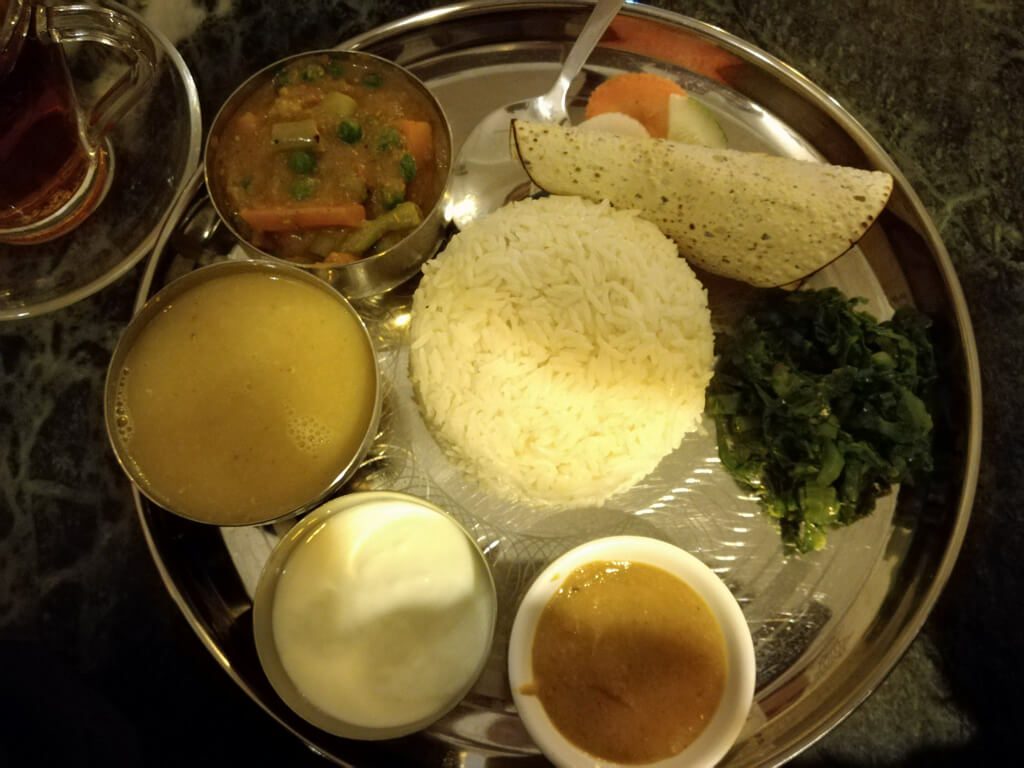
Annapurna Circuit Trek is one of the most popular teahouse treks in Nepal. Thus, you will find many teahouses along the trail. The accommodation costs range from $1 to $3, depending on the altitude. If you are trekking in the offseason, you can get free accommodation if you have the food from the same teahouse.
The teahouses are pretty basic and provide basic rooms on twin-sharing basic. You will have a bed with a pillow, a mattress, and a blanket. There won’t be an electric socket in the rooms as solar power is a significant source of electricity.
Thus, if you want to charge your phones, you must charge them in the common area at a specific cost. Hot showers generally cost around $1 in the teahouses. WiFi is available at lower elevations, but you do not expect these facilities as you move up the trails.
Furthermore, the foods offered by the teahouse are pretty basic as well, and you will get served the Nepalese meal of “Dal Bhat” in most teahouses. Besides that, they also offer other varieties of food such as pizza, pasta, spaghetti, etc. To be safe from any hassle, you must book these accommodations early, especially during the offseason.
The Final Say
Annapurna Circuit Trek offers an incredible trekking experience with magnificent natural and cultural beauty. That is why this trek is famous among trekkers from all around the world. Anyone with a basic level of fitness can complete this exciting trek.
Many trekkers are not sure about how to prepare for Annapurna Circuit Trek. I hope this blog will help you prepare and plan the trek. Furthermore, if you have any more questions or queries, please get in touch with us.
